Feasibility of UTS Smart Home to Support Sustainable Development Goals of United Nations (UN SDGs): Water and Energy Conservation
Abstract
1. Introduction
2. Related Works
3. Materials and Methods
3.1. UTS Smart Home
3.1.1. Building Architecture Design
3.1.2. Functionalities of the UTS SH
3.2. System Architecture
3.3. Smart Home Hardware
3.4. Smart-Home Software and Cloud Framework
3.4.1. IoT Cloud Platform
3.4.2. Decision Support System (DSS)
3.5. Sustainability Analysis of the UTS SH in Resource Conservation
3.5.1. Smart Home Energy Management System (SHEMS)
3.5.2. Smart Water Management (SWM)
4. Results and Discussions
4.1. Resource Conservation on Electricity
4.1.1. Electrical Energy Consumption and Load Profile
4.1.2. PV-Generated Electricity Supply
4.2. Resource Conservation on Water
Use Case of Smart Water Management in the UTS SH
5. Conclusions
Author Contributions
Funding
Institutional Review Board Statement
Informed Consent Statement
Data Availability Statement
Acknowledgments
Conflicts of Interest
References
- Edenhofer, O.; Pichs-Madruga, R.; Sokona, Y.; Farahani, E.; Kadner, S.; Seyboth, K.; Adler, A.; Baum, I.; Brunner, S.; Eickemeier, P. Climate Change 2014: Mitigation of Climate Change: Working Group III Contribution to the IPCC Fifth Assessment Report; Cambridge University Press: Cambridge, UK, 2015; ISBN 9781107058217. [Google Scholar]
- Rosenzweig, C.; Solecki, W.; Hammer, S.A.; Mehrotra, S. Cities lead the way in climate-change action. Nature 2010, 467, 909–911. [Google Scholar] [CrossRef] [PubMed]
- Ercin, A.E.; Hoekstra, A.Y. Water footprint scenarios for 2050: A global analysis. Environ. Int. 2014, 64, 71–82. [Google Scholar] [CrossRef] [PubMed]
- Todaro, M.; Smith, S.C. Economic Development, 7th ed.; Addison Wesley Inc.: Cambridge, MA, USA, 2000; ISBN 9780138013882. [Google Scholar]
- Khan, A.; Chenggang, Y.; Bano, S.; Hussain, J. The empirical relationship between environmental degradation, economic growth, and social well-being in Belt and Road Initiative countries. Environ. Sci. Pollut. Res. 2020, 27, 30800–30814. [Google Scholar] [CrossRef] [PubMed]
- Wang, W.; Straffelini, E.; Pijl, A.; Tarolli, P. Sustainable water resource management in steep-slope agriculture. Geogr. Sustain. 2022, 3, 214–219. [Google Scholar] [CrossRef]
- Lamb, W.F.; Wiedmann, T.; Pongratz, J.; Andrew, R.; Crippa, M.; Olivier, J.G.J.; Wiedenhofer, D.; Mattioli, G.; Khourdajie, A.A.; House, J.; et al. A review of trends and drivers of greenhouse gas emissions by sector from 1990 to 2018. Environ. Res. Lett. 2021, 16, 073005. [Google Scholar] [CrossRef]
- Suruhanjaya Tenaga (Energy Commission). Malaysia Energy Statistics Handbook 2020; Suruhanjaya Tenaga (Energy Commission): Putrajaya, Malaysia, 2020. [Google Scholar]
- Shaikh, P.H.; Nor, N.B.M.; Sahito, A.A.; Nallagownden, P.; Elamvazuthi, I.; Shaikh, M.S. Building energy for sustainable development in Malaysia: A review. Renew. Sustain. Energy Rev. 2017, 75, 1392–1403. [Google Scholar] [CrossRef]
- Energy Commision (Suruhanjaya Tenanga). National Energy Balance 2019; Energy Commision (Suruhanjaya Tenanga): Putrajaya, Malaysia, 2019. [Google Scholar]
- Global Alliance for Buildings and Construction. 2019 Global Status Report for Buildings and Construction Sector|UNEP—UN Environment Programme; Global Alliance for Buildings and Construction: Paris, France, 2019; ISBN 9789280737684. [Google Scholar]
- Emekci, S. From Smart Homes to Smart Cities: How Smart Homes Contribute to the Sustainable Development Goals. In Smart Cities, Citizen Welfare, and the Implementation of Sustainable Development Goals; Pego, A., Ed.; IGI Global: Hershey, PA, USA, 2022; pp. 321–337. [Google Scholar] [CrossRef]
- Li, M.; Gu, W.; Chen, W.; He, Y.; Wu, Y.; Zhang, Y. Smart home: Architecture, technologies and systems. Procedia Comput. Sci. 2018, 131, 393–400. [Google Scholar] [CrossRef]
- Lutolf, R. Smart Home concept and the integration of energy meters into a home based system. In Proceedings of the 7th International Conference on Metering Apparatus and Tariffs for Electricity Supply, Glasgow, UK, 17–19 November 1992; pp. 277–278. [Google Scholar]
- Ad van Berlo, B.A. Design Guidelines on Smart Homes: A COST 219bis Guidebook—Google Books; COST, European Co-Operation in the Field of Scientific and Technical Research: Eindhoven, The Netherlands, 1999. [Google Scholar]
- Briere, D.D.; Hurley, P.J. Smart Homes for Dummies; Wiley: Hoboken, NJ, USA, 2003; ISBN 978-0-764-52539-1. [Google Scholar]
- Satpathy, L. Smart Housing: Technology to Aid Aging in Place—New Opportunities and Challenges. Master’s Thesis, Mississippi State University, Starkville, MS, USA, 2006; p. 192. [Google Scholar]
- Creaney, R.; Reid, L.; Currie, M. The contribution of healthcare smart homes to older peoples’ wellbeing: A new conceptual framework. Wellbeing Space Soc. 2021, 2, 100031. [Google Scholar] [CrossRef]
- IEA World Energy Outlook. 2021. Available online: https://www.iea.org/reports/world-energy-outlook-2021/executive-summary (accessed on 2 August 2022).
- Schieweck, A.; Uhde, E.; Salthammer, T.; Salthammer, L.C.; Morawska, L.; Mazaheri, M.; Kumar, P. Smart homes and the control of indoor air quality. Renew. Sustain. Energy Rev. 2018, 94, 705–718. [Google Scholar] [CrossRef]
- Van Thillo, L.; Verbeke, S.; Audenaert, A. The potential of building automation and control systems to lower the energy demand in residential buildings: A review of their performance and influencing parameters. Renew. Sustain. Energy Rev. 2022, 158, 112099. [Google Scholar] [CrossRef]
- Cook, D.J.; Youngblood, M.; Heierman, E.O.; Gopalratnam, K.; Rao, S.; Litvin, A.; Khawaja, F. MavHome: An agent-based smart home. In Proceedings of the 1st IEEE International Conference on Pervasive Computing and Communications, Fort Worth, TX, USA, 26 March 2003; pp. 521–524. [Google Scholar] [CrossRef]
- Ali, M.M. Smart Cities, Citizen Welfare, and the Implementation of Sustainable Development Goals; Pego, A.C., Ed.; Advances in Public Policy and Administration; IGI Global: Hershey, PA, USA, 2021; ISBN 9781799877851. [Google Scholar]
- Peruzzini, M.; Germani, M.; Papetti, A.; Capitanelli, A. Smart Home Information Management System for Energy-Efficient Networks; IFIP Advances in Information and Communication Technology; Springer: Berlin/Heidelberg, Germany, 2013; pp. 393–401. [Google Scholar] [CrossRef]
- Cordopatri, A.; De Rose, R.; Felicetti, C.; Lanuzza, M.; Cocorullo, G. Hardware implementation of a Test Lab for Smart Home environments. In Proceedings of the 2015 AEIT International Annual Conference, AEIT 2015, Naples, Italy, 14–16 October 2015; Institute of Electrical and Electronics Engineers Inc.: New York, NY, USA, 2015. [Google Scholar]
- AlFaris, F.; Juaidi, A.; Manzano-Agugliaro, F. Intelligent homes’ technologies to optimize the energy performance for the net zero energy home. Energy Build. 2017, 153, 262–274. [Google Scholar] [CrossRef]
- Guedey, M.; Uckelmann, D. Exploring Smart Home and Internet of Things Technologies for Smart Public Buildings; ACM International Conference Proceeding Series; Association for Computing Machinery: New York, NY, USA, 2020. [Google Scholar]
- Espinilla, M.; Martinez, L.; Medina, J.; Nugent, C. The experience of developing the UJAmI Smart Lab. IEEE Access 2018, 6, 34631–34642. [Google Scholar] [CrossRef]
- Stolojescu-Crisan, C.; Crisan, C.; Butunoi, B.P. An IoT-Based Smart Home Automation System. Sensors 2021, 21, 3784. [Google Scholar] [CrossRef] [PubMed]
- Mokhtari, G.; Anvari-Moghaddam, A.; Zhang, Q. A New Layered Architecture for Future Big Data-Driven Smart Homes. IEEE Access 2019, 7, 19002–19012. [Google Scholar] [CrossRef]
- Kim, J.E.; Barth, T.; Boulos, G.; Yackovich, J.; Beckel, C.; Mosse, D. Seamless integration of heterogeneous devices and access control in smart homes and its evaluation. Intell. Build. Int. 2015, 9, 23–39. [Google Scholar] [CrossRef]
- Kubota, T.; Jeong, S.; Toe, D.; Ossen, D. Energy Consumption and Air-Conditioning Usage in Residential Buildings of Malaysia. J. Int. Dev. Coop. 2011, 17, 61–69. [Google Scholar] [CrossRef]
- Sibu, Malaysia Weather History|Weather Underground. Available online: https://www.wunderground.com/history/monthly/my/sibu (accessed on 18 July 2022).
- Maria, W. Saxton The Ecological Footprints of Tiny Home Downsizers: An Exploratory Study; Virginia Polytechnic Institute and State University: Blacksburg, VA, USA, 2019. [Google Scholar]
- Akadiri, P.O.; Chinyio, E.A.; Olomolaiye, P.O. Design of a sustainable building: A conceptual framework for implementing sustainability in the building sector. Buildings 2012, 2, 126–152. [Google Scholar] [CrossRef]
- Pajonk, A.; Prieto, A.; Blum, U.; Knaack, U. Multi-material additive manufacturing in architecture and construction: A review. J. Build. Eng. 2022, 45, 103603. [Google Scholar] [CrossRef]
- 7 IOT Layers That You Should Know in 2021. Available online: https://www.jigsawacademy.com/4-layers-of-the-internet-of-things/ (accessed on 19 January 2022).
- Welcome to Flask—Flask Documentation (2.0.X). Available online: https://flask.palletsprojects.com/en/2.0.x/ (accessed on 2 March 2022).
- Kee, K.K.; Yew, S.L.B.; Lim, Y.S.; Ting, Y.P.; Rashidi, R. Universal cyber physical system, a prototype for predictive maintenance. Bull. Electr. Eng. Inform. 2022, 11, 42–49. [Google Scholar] [CrossRef]
- Kee, K.K.; Lim, Y.S.; Wong, J.; Chua, K.H. Cloud-based non-intrusive load monitoring system (NILM). Int. J. Eng. Adv. Technol. 2019, 8, 125–131. [Google Scholar] [CrossRef]
- Kee, K.-K.; Lau, S.; Lau, Y.H.; Bin Rashidi, R. Intelligent Cloud-based Electrical Socket (iCESocket) for Smart Home Applications. BORNEO J. Sci. Technol. 2022, 4, 60–72. [Google Scholar] [CrossRef]
- Lau, K.Y.; Tan, C.W.; Ching, K.Y. The implementation of grid-connected, residential rooftop photovoltaic systems under different load scenarios in Malaysia. J. Clean. Prod. 2021, 316, 128389. [Google Scholar] [CrossRef]
- Yamusa, I.B.; Ismail, M.S.; Tella, A. Highway Proneness Appraisal to Landslides along Taiping to Ipoh Segment Malaysia, Using MCDM and GIS Techniques. Sustainability 2022, 14, 9096. [Google Scholar] [CrossRef]
- Lani, N.H.M.; Yusop, Z.; Syafiuddin, A. A Review of Rainwater Harvesting in Malaysia: Prospects and Challenges. Water 2018, 10, 506. [Google Scholar] [CrossRef]
- Ahmed, M.S.; Mohamed, A.; Homod, R.Z.; Shareef, H.; Khalid, K. Awareness on energy management in residential buildings: A case study in Kajang and Putrajaya. J. Eng. Sci. Technol. 2017, 12, 1280–1294. [Google Scholar]
- Wu, Y.K.; Huang, C.L.; Phan, Q.T.; Li, Y.Y. Completed Review of Various Solar Power Forecasting Techniques Considering Different Viewpoints. Energies 2022, 15, 3320. [Google Scholar] [CrossRef]
- Firmanda, D.; Riza, A.; Ihtsham-Ul, S.; Gilani, H. Standalone Photovoltaic System Sizing using Peak Sun Hour Method and Evaluation by TRNSYS Simulation. Int. J. Renew. Energy Res. 2014, 4, 109–114. [Google Scholar] [CrossRef]
- Sánchez, E.; Ordóñez, Á.; Sánchez, A.; Ovejero, R.G.; Parra-Domínguez, J. Exploring the Benefits of Photovoltaic Non-Optimal Orientations in Buildings. Appl. Sci. 2021, 11, 9954. [Google Scholar] [CrossRef]
- World Bank Group World Bank Group. Global Solar Atlas World Bank Group. 2022. Available online: https://globalsolaratlas.info/map (accessed on 5 August 2022).
- Hossain, M.Z.; Illias, H.A. Binary power generation system by utilizing solar energy in Malaysia. Ain Shams Eng. J. 2022, 13, 101650. [Google Scholar] [CrossRef]
- Official Website of Kuching Water Board. Available online: https://www.kwb.gov.my/page-0-171-79-Water-Rates.html (accessed on 14 August 2022).
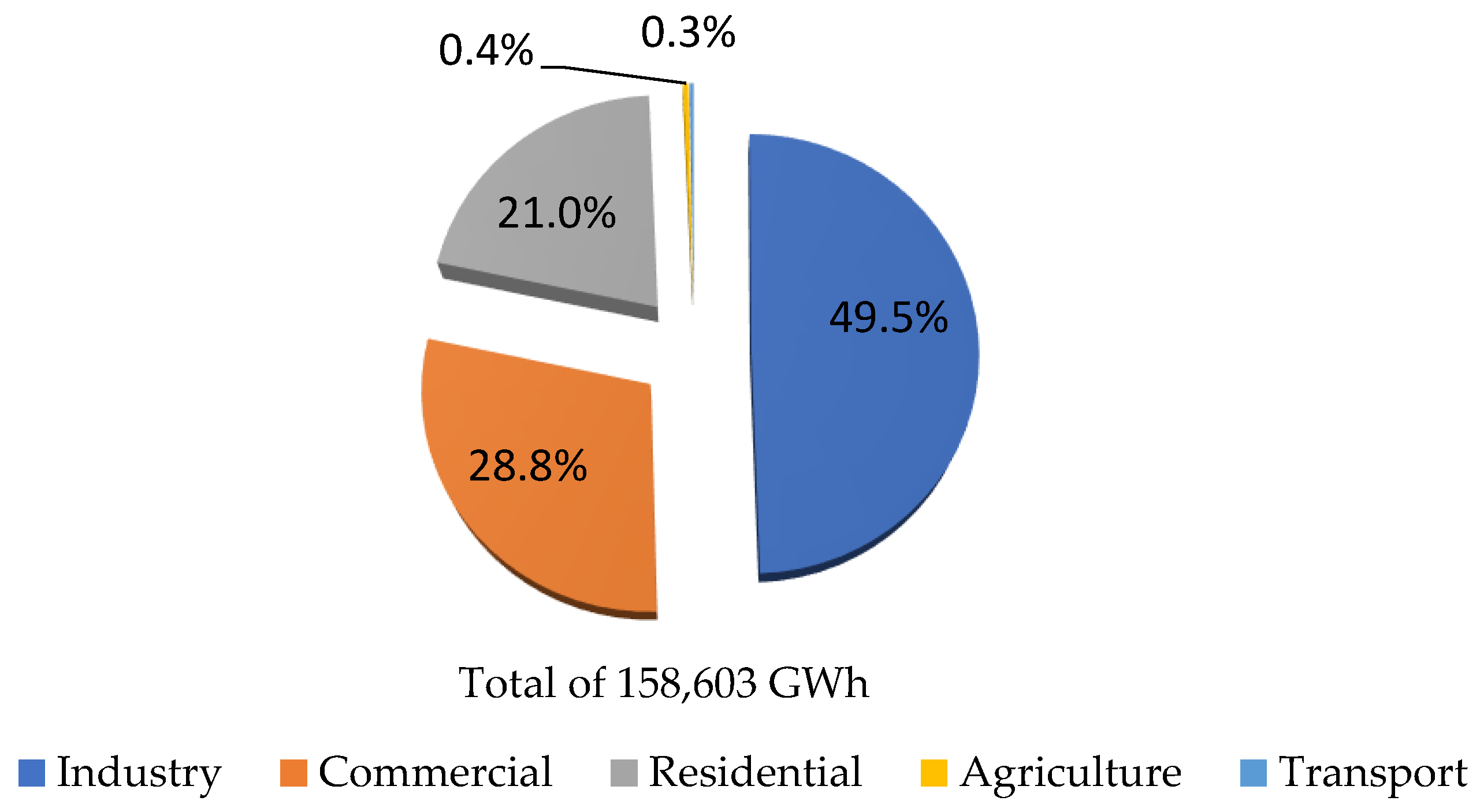
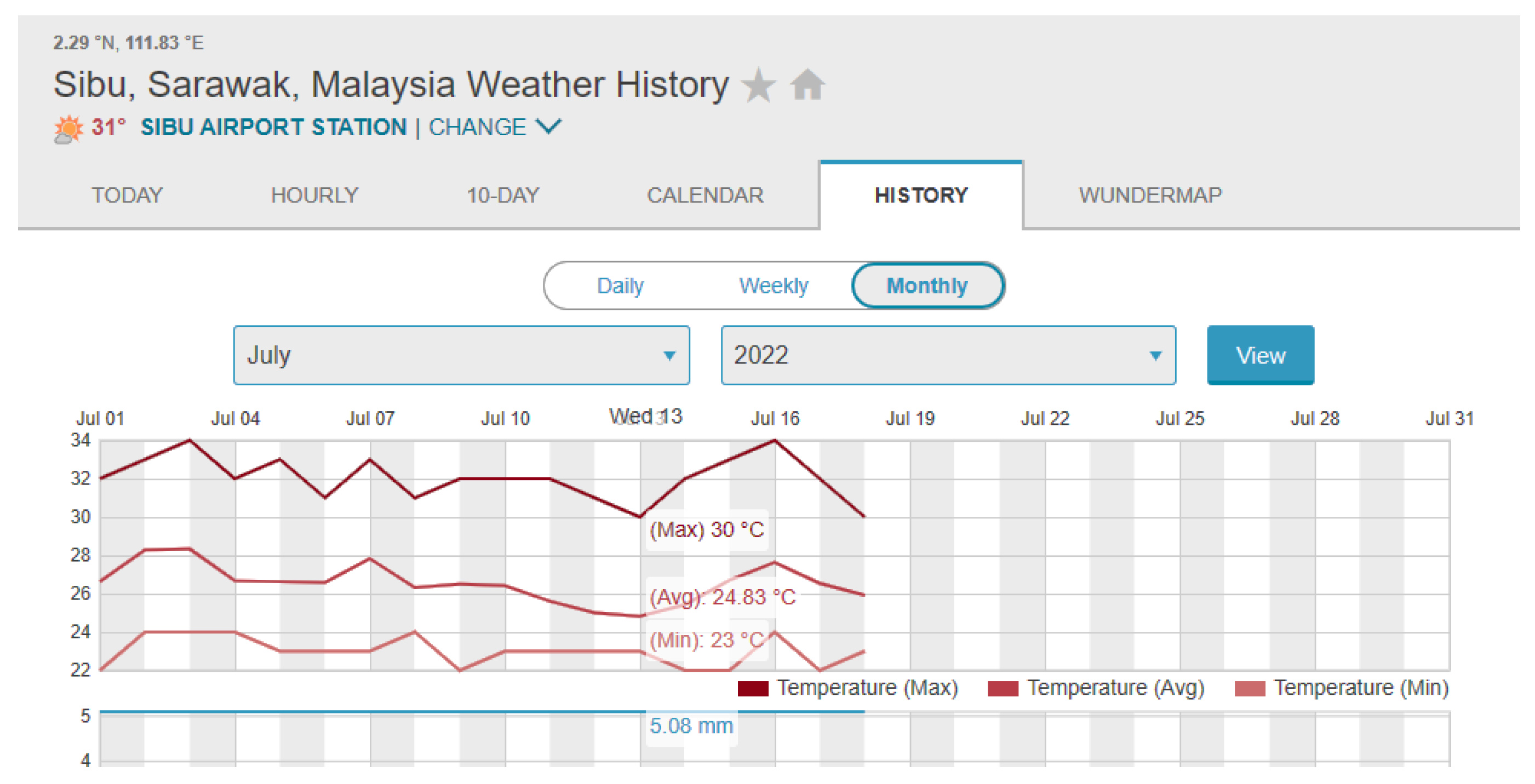
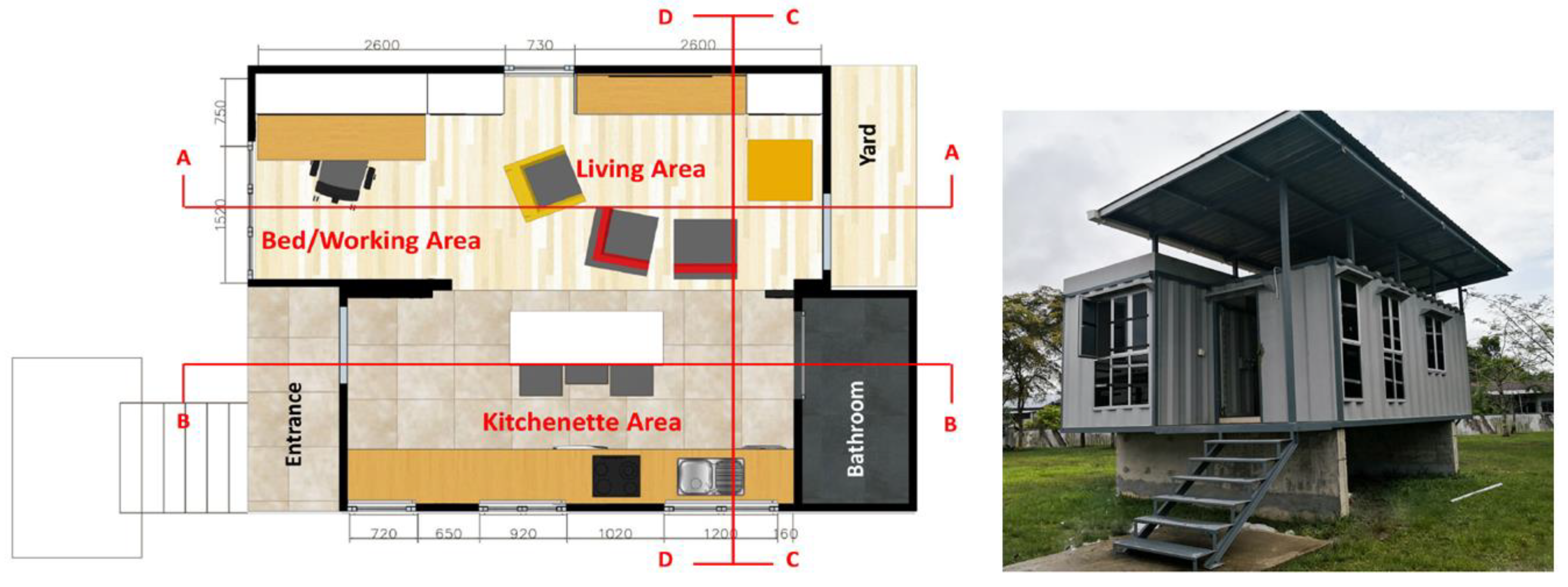
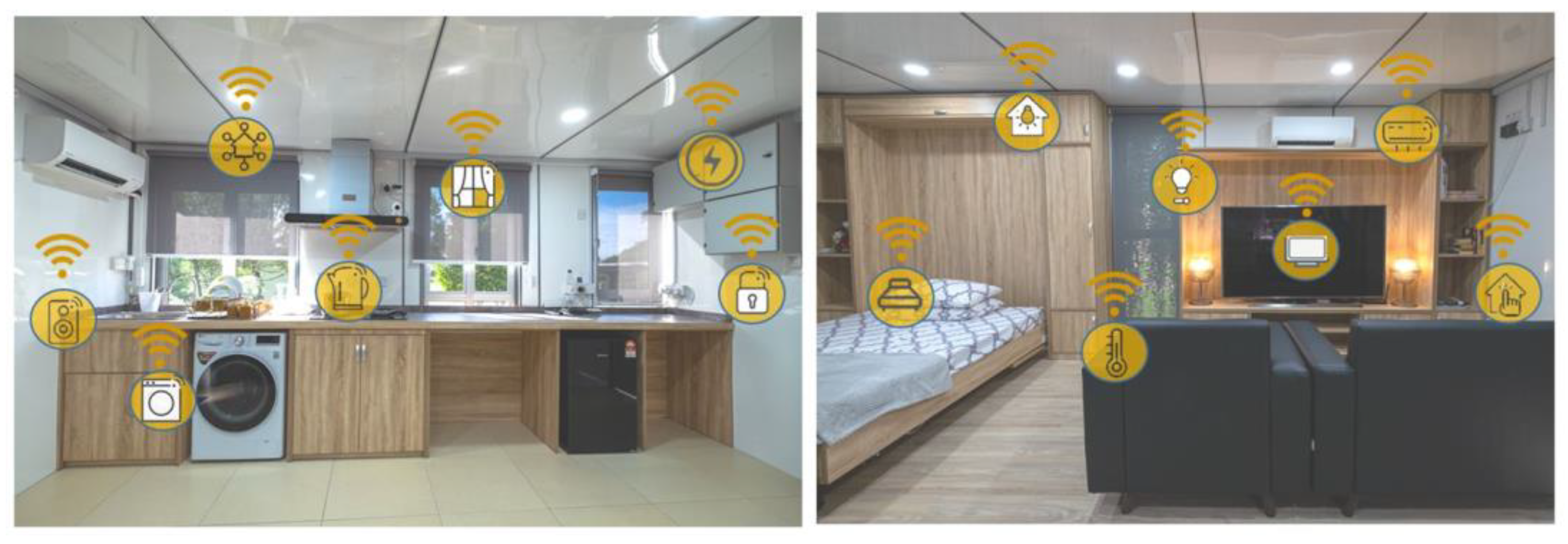
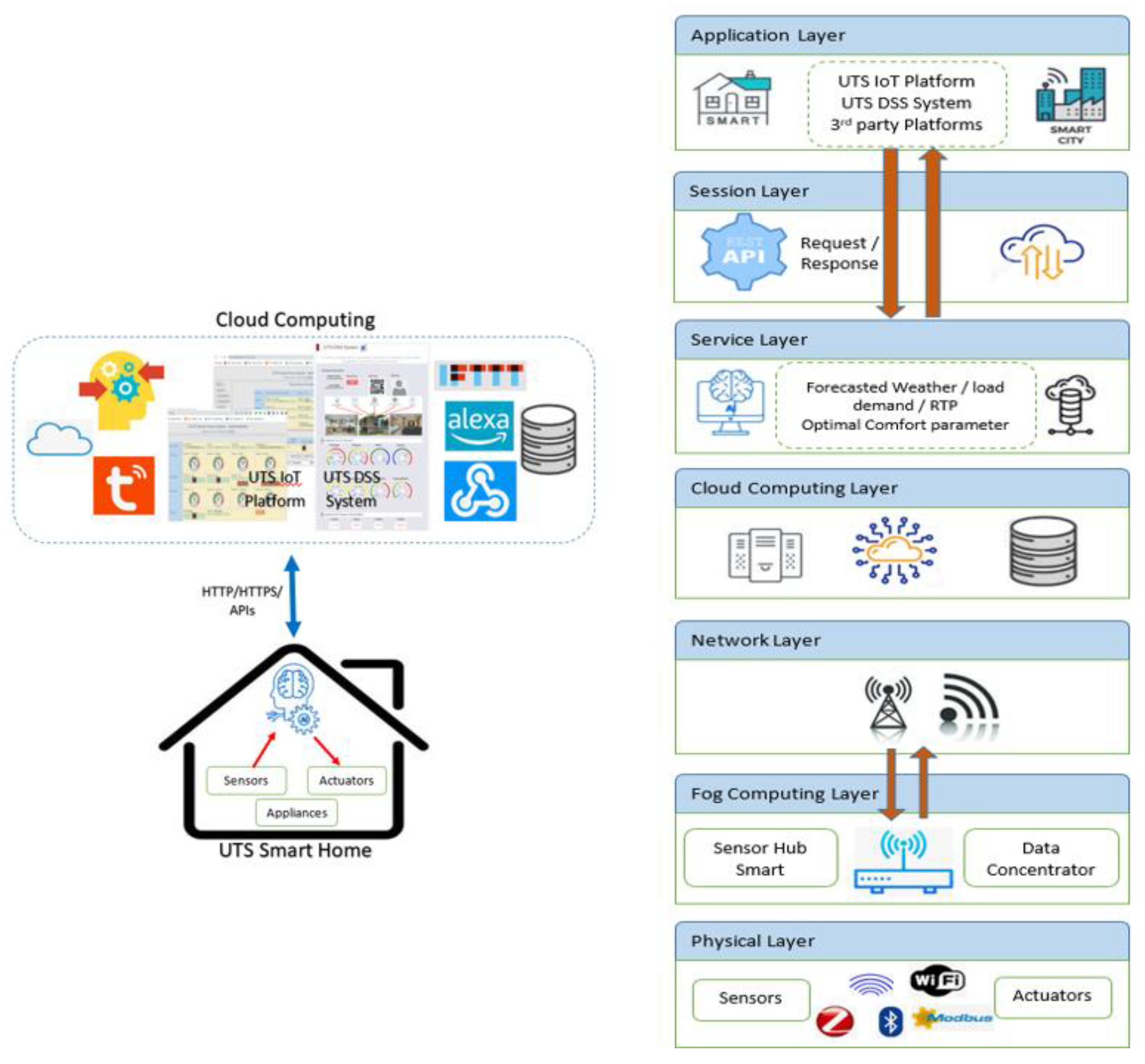
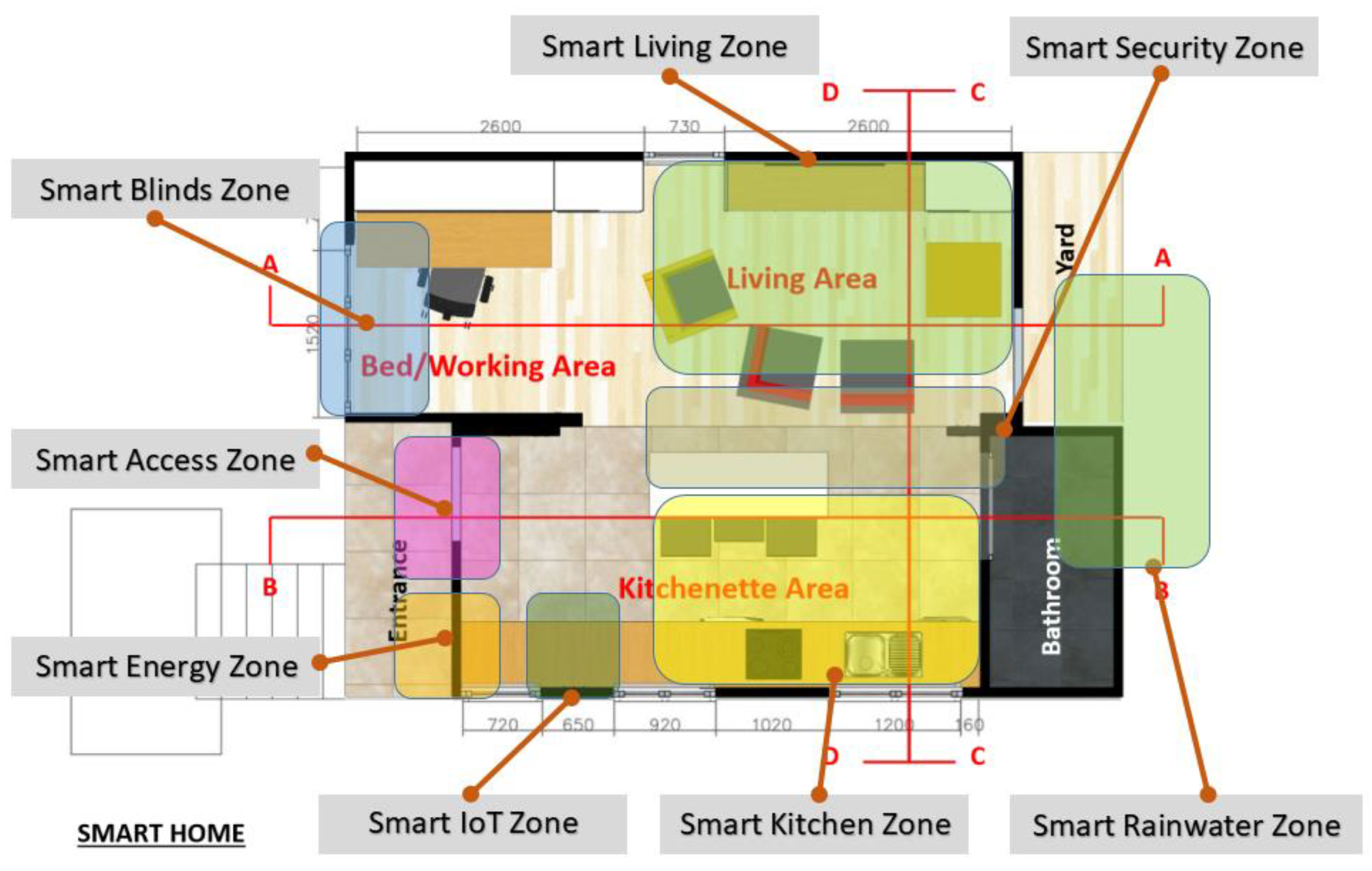
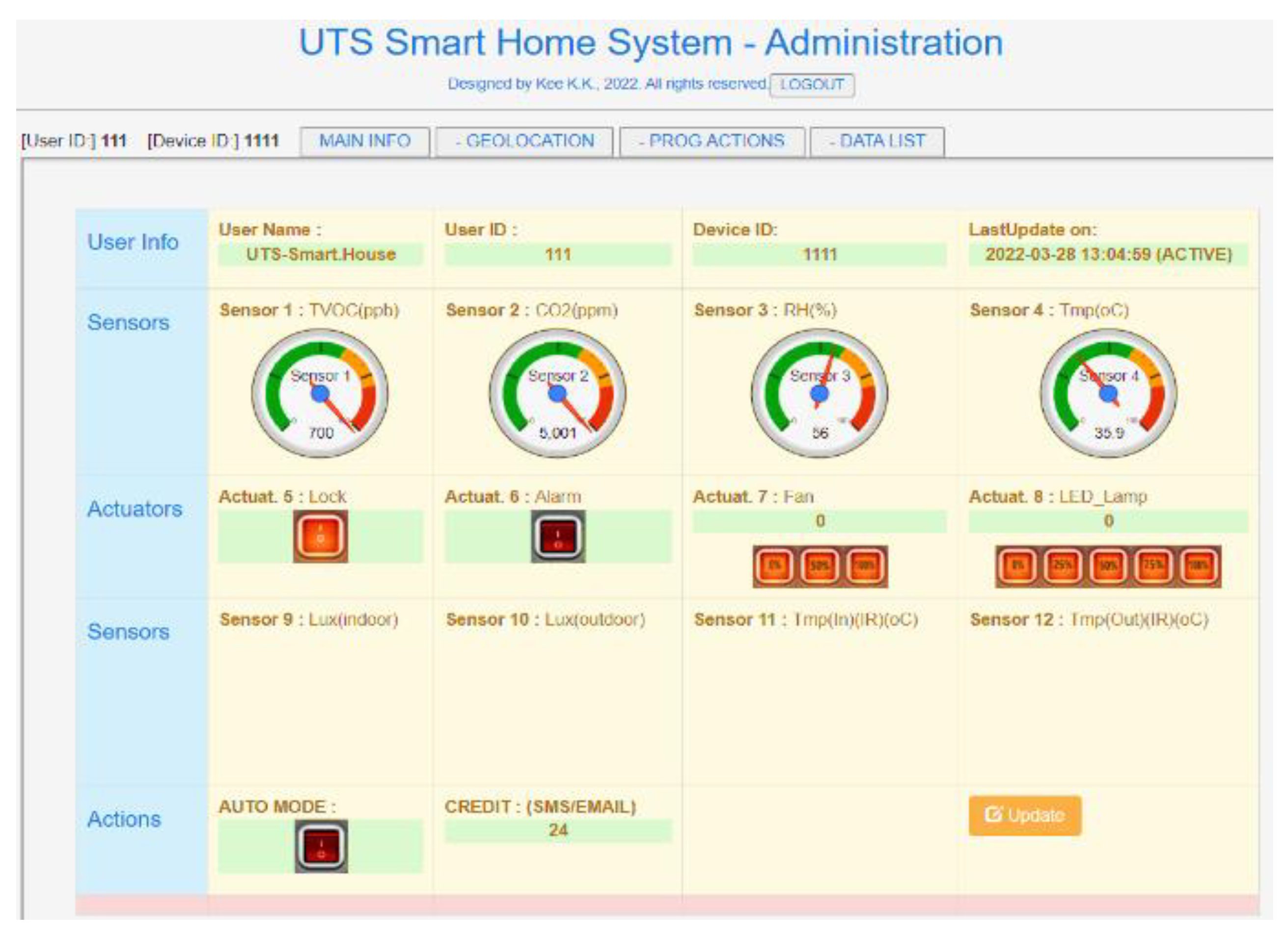


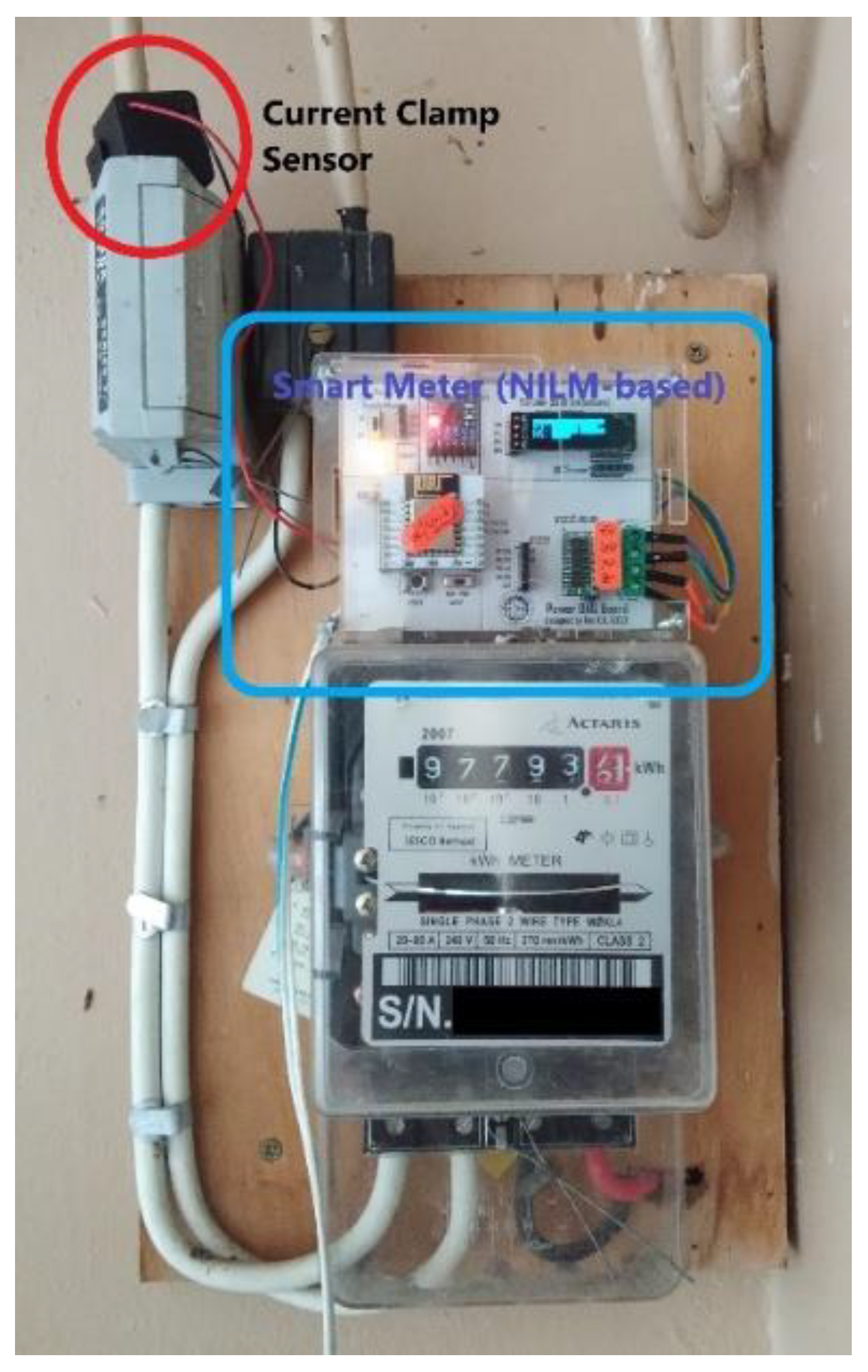

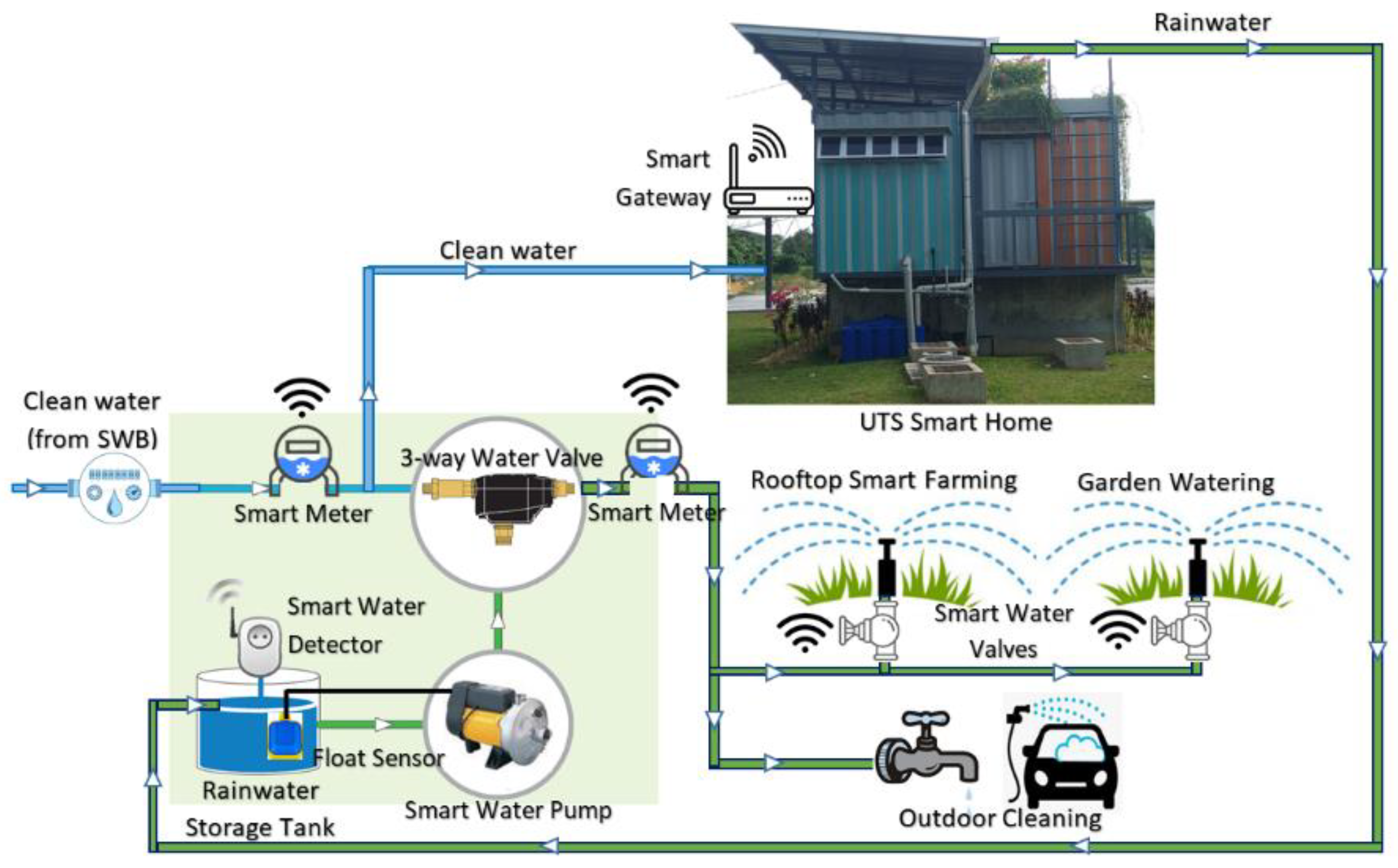
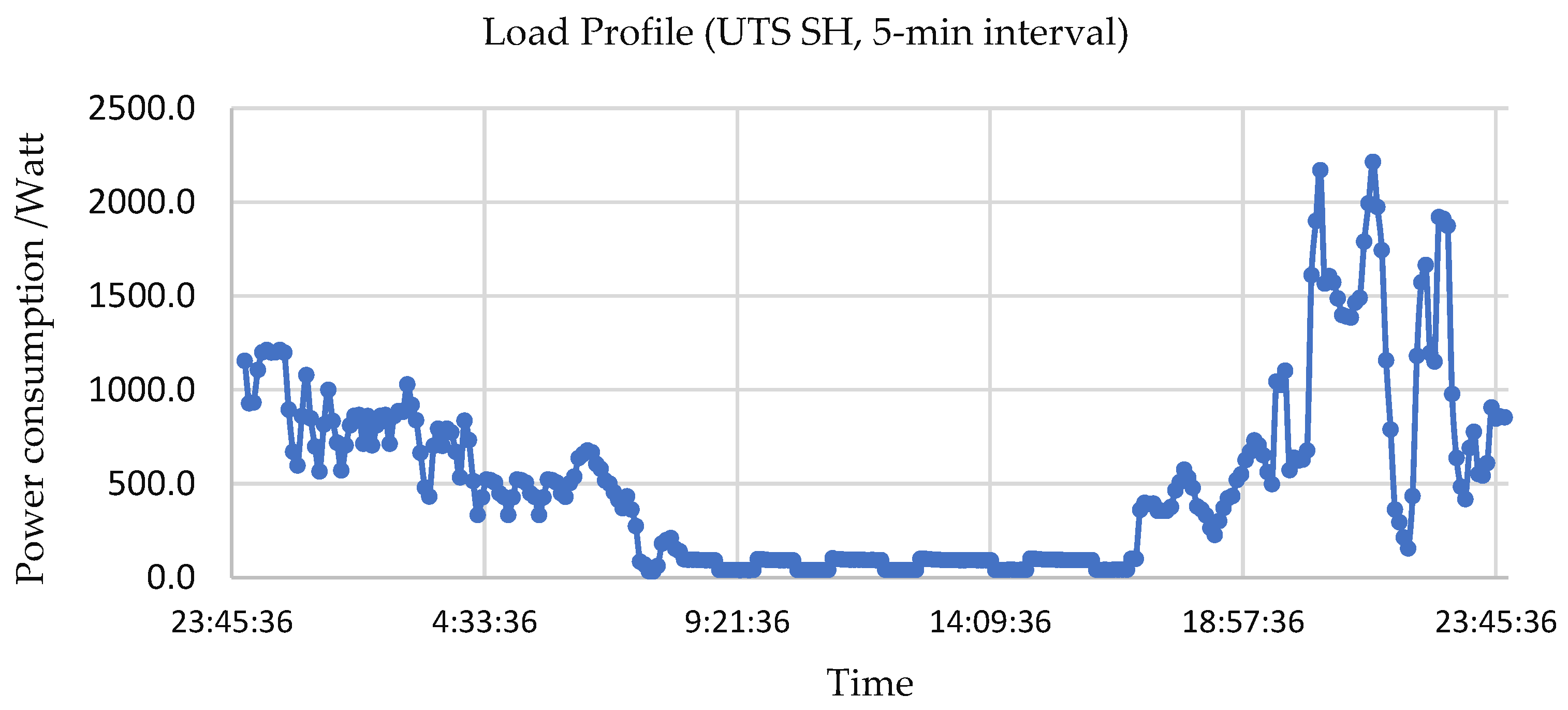
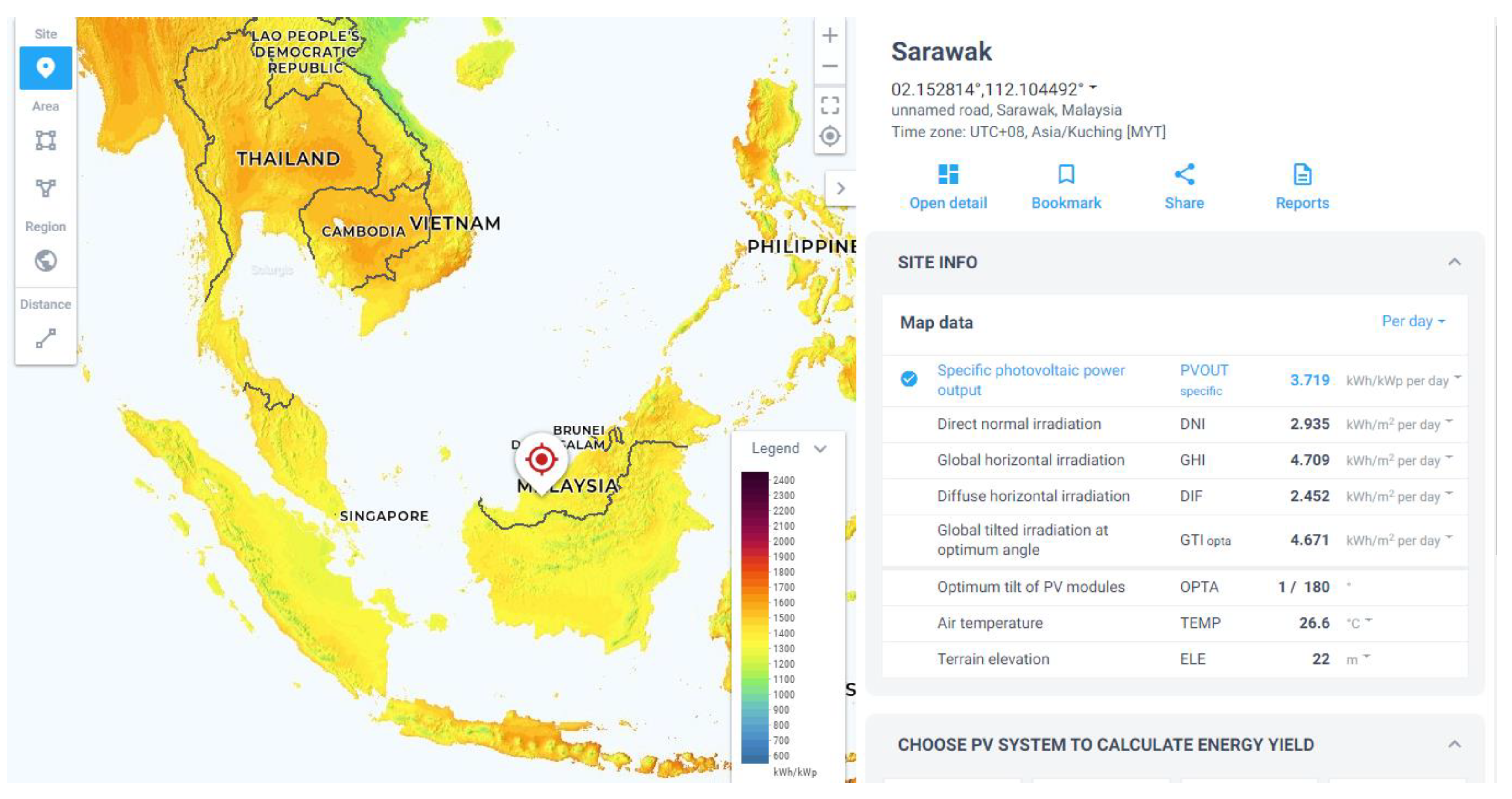

| Energy Efficiency | Quality of Life | Security and Safety | Conservation |
|---|---|---|---|
| Harnessing and storage of energy from renewable sources. Reduce, optimize, and make efficient use of energy consumption. | Maintain well-being and healthiness of occupants, complying with building standards with better market value and extended lifespan. | Prevent, detect, and mitigate the threats such as intruders, fire, gas leakage, CO2, and poor indoor air quality. | Conserve natural resources (energy and water). Reduce wastes and pollutants in the environment. |
 | 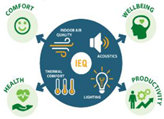 |  |  |
| No. | Item | Power P (Watt) | Qty N | Operation Hours, h | Wh/day |
|---|---|---|---|---|---|
| 1 | Lamp (outdoor) | 12 | 2 | 6 | 144 |
| 2 | Lamp (indoor) | 12 | 6 | 6 | 432 |
| 3 | Fans | 80 | 1 | 6 | 480 |
| 4 | Air-conditioner | 800 | 1 | 4 | 3200 |
| 5 | Television | 100 | 1 | 2 | 200 |
| 6 | Cooker hob | 1000 | 1 | 0.4 | 400 |
| 7 | Kettle | 1000 | 1 | 0.4 | 400 |
| 8 | Water heater | 1000 | 1 | 0.5 | 500 |
| 9 | Washing machine | 1000 | 1 | 0.6 | 600 |
| 10 | Refrigerator | 100 | 1 | 24 | 2400 |
| 11 | Miscellaneous (ICT and plug loads) | 500 | 1 | 4 | 2000 |
| kWh (daily) | 10.76 | ||||
| kWh (monthly) | 322.68 | ||||
| Minimum charge in any one month | RM4.40 |
| 1000 to 15,000 L | RM0.48 per 1000 L |
| In excess of 15,000 liters, but not exceeding 50,000 L | RM0.72 per 1000 L |
| The excess over 50,000 L | RM0.76 per 1000 L |
| Total number of residents: | 2 |
| Water meter reading 1, (supply water): | 9.1 (‘000) L |
| Water meter reading 2, (rainwater): | 2.5 (‘000) L |
| Total water consumption (per household): | 11.6 (‘000) L |
| Daily water consumption (per capita, lcd): | 193 liters or 193 lcd |
| Total water saving (liters): | 2.5 (‘000) L |
| Total water saving (in percentage): | 21.6% |
Publisher’s Note: MDPI stays neutral with regard to jurisdictional claims in published maps and institutional affiliations. |
© 2022 by the authors. Licensee MDPI, Basel, Switzerland. This article is an open access article distributed under the terms and conditions of the Creative Commons Attribution (CC BY) license (https://creativecommons.org/licenses/by/4.0/).
Share and Cite
Kee, K.-K.; Ting, H.-Y.; Lim, Y.-S.; Ting, J.-T.-W.; Peter, M.; Ibrahim, K.; Show, P.L. Feasibility of UTS Smart Home to Support Sustainable Development Goals of United Nations (UN SDGs): Water and Energy Conservation. Sustainability 2022, 14, 12242. https://doi.org/10.3390/su141912242
Kee K-K, Ting H-Y, Lim Y-S, Ting J-T-W, Peter M, Ibrahim K, Show PL. Feasibility of UTS Smart Home to Support Sustainable Development Goals of United Nations (UN SDGs): Water and Energy Conservation. Sustainability. 2022; 14(19):12242. https://doi.org/10.3390/su141912242
Chicago/Turabian StyleKee, Keh-Kim, Huong-Yong Ting, Yun-Seng Lim, Jackie-Tiew-Wei Ting, Marcella Peter, Khairunnisa Ibrahim, and Pau Loke Show. 2022. "Feasibility of UTS Smart Home to Support Sustainable Development Goals of United Nations (UN SDGs): Water and Energy Conservation" Sustainability 14, no. 19: 12242. https://doi.org/10.3390/su141912242
APA StyleKee, K.-K., Ting, H.-Y., Lim, Y.-S., Ting, J.-T.-W., Peter, M., Ibrahim, K., & Show, P. L. (2022). Feasibility of UTS Smart Home to Support Sustainable Development Goals of United Nations (UN SDGs): Water and Energy Conservation. Sustainability, 14(19), 12242. https://doi.org/10.3390/su141912242








